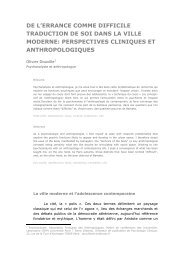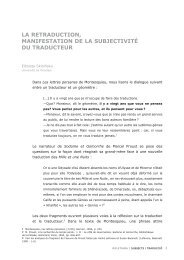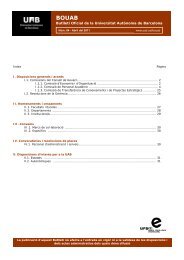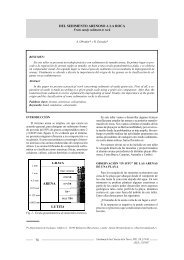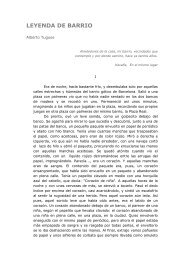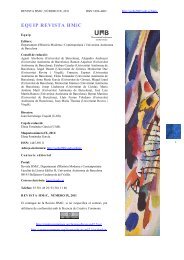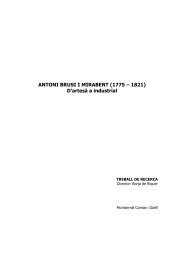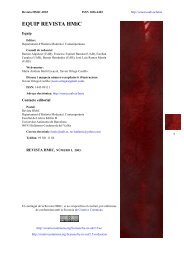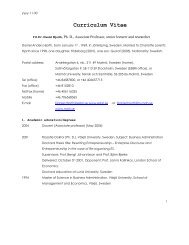EQUIP REVISTA HMiC - Universitat Autònoma de Barcelona
EQUIP REVISTA HMiC - Universitat Autònoma de Barcelona
EQUIP REVISTA HMiC - Universitat Autònoma de Barcelona
Create successful ePaper yourself
Turn your PDF publications into a flip-book with our unique Google optimized e-Paper software.
Marginalization Insi<strong>de</strong>-Out:Thoughts on Contemporary Chinese and Sinophone Literature<br />
Contemporary literature, in this sense, is the hypothetic oppressor that classical sinologists—<br />
scholars who nowadays still have an important weight in <strong>de</strong>signing curricula and directing<br />
research interests—need to get controlled, oppressed and marginalized.<br />
Also, and focusing at this point especially on the literature from the PRC, it must be noticed<br />
that women writers, authors from national minorities or writers from repressed collectives such<br />
as the homosexual don’t have a voice in the (official) literary sphere. 32 Since the Communist<br />
Chinese Party has appropriated the agency speaking for minorities in its official and national<br />
discourse—“a continual investment in minority, in suffering, and in victimization” 33 —the real<br />
minorities and subaltern collectives, then, remain silenced. As Chow puts it in the case of<br />
women: “Chinese women are, in terms of the structure of discourse, a kind of minor of the<br />
minor, the other to the woman that is Chinese man [vis-à-vis the West].” 34 The same analogy<br />
could probably be ma<strong>de</strong> with the other members of the marginalized collectives or national<br />
minorities. In these cases, the parallelism with Gayatri Spivak’s notion of the subaltern, unable<br />
to speak because her voice has already been represented by someone else, is probably quite<br />
precise. 35<br />
This situation in the PRC literary scene colli<strong>de</strong>s with the transnational dynamic in which<br />
Chinese literature has apparently enrolled. Yet, although the Chinese works published in the<br />
West are by authors from different origins and characteristics (diaspora, exiled, woman writers),<br />
they generally display a specific type of literature—such as autobiographies, for example—that<br />
the Western market welcomes to consi<strong>de</strong>r and incorporate, in part precisely because it is<br />
oppressed (or even censored) in China. This is what Shih calls the “exceptional particular,” a<br />
logic exerced by the Eurocentric canon by which “particular works cannot be universal unless<br />
they are exceptional.” Therefore, “granting universality to the exceptional particular—the<br />
singular—thus in no way compromises standards of the universal, nor does it threaten the<br />
guardians of the universal.” 36 In this sense, the internal marginalization within the PRC<br />
paradoxically favorizes the external promotion of these works, even if it is by acting as an<br />
obstacle for a fluid integration of PRC literature in the global domain of Chinese literature, and<br />
forbidding a literary richness that should be a way to oppose the exclusivity of the Western<br />
canon and its own minority status.<br />
Another aspect that should also be taken into account is the usual ten<strong>de</strong>ncy to consi<strong>de</strong>r as<br />
Chinese literature only the works coming from the PRC. Facing this source of oppression, it<br />
seems imperative to divi<strong>de</strong> the literary writings in Chinese language into, on the one hand,<br />
Chinese literature or the works that certainly come from the PRC and, on the other hand, what<br />
Shu-mei Shih has called Sinophone literature, “literature written in Chinese by Chinesespeaking<br />
writers in various parts of the world outsi<strong>de</strong> China.” 37 This distinction wants to<br />
“contest the neglect and marginalization of literatures in Chinese published outsi<strong>de</strong> China and<br />
32. For two of the first attempts to challenge this situation in English translation, see: Sieber, Patricia, Red<br />
Is Not the Only Color: Contemporary Chinese Fiction on Love and Sex between Women, Collected<br />
Stories. Lanham: Rowman & Littlefield, 2001; and Martin, Fran, Angelwings: Contemporary Queer<br />
Fiction from Taiwan. Honolulu: University of Hawaii Press, 2003.<br />
33. Chow, Writing Diaspora, 107.<br />
34. Ibid., 112.<br />
35. Spivak, Gayatri, “Can the Subaltern Speak?,” in Williams, Patrick and Chrisman, Laura, eds., Colonial<br />
Discourse and Post-colonial Theory: A Rea<strong>de</strong>r. New York: Columbia University Press, 1994, 66-111.<br />
36. Shih, “Global Literature and the Technologies of Recognition,” 26.<br />
37. Ibid., 29.<br />
http://seneca.uab.es/hmic Revista <strong>HMiC</strong>, número IV, 2006<br />
48



